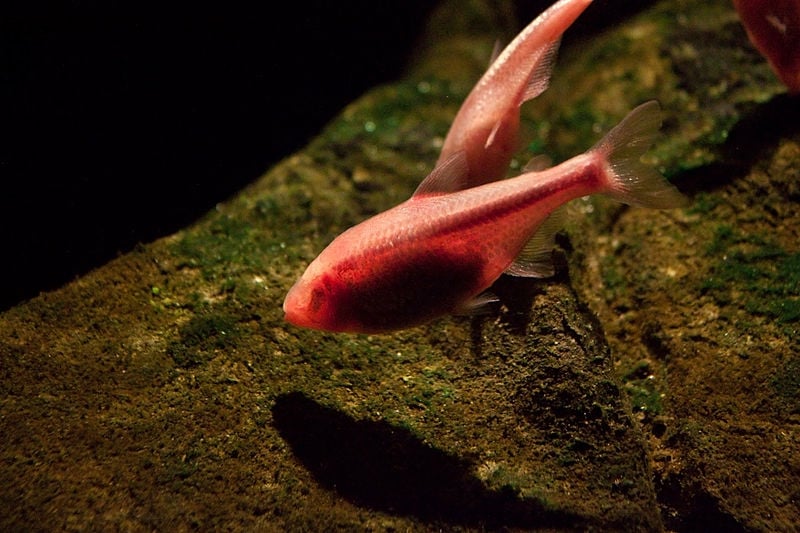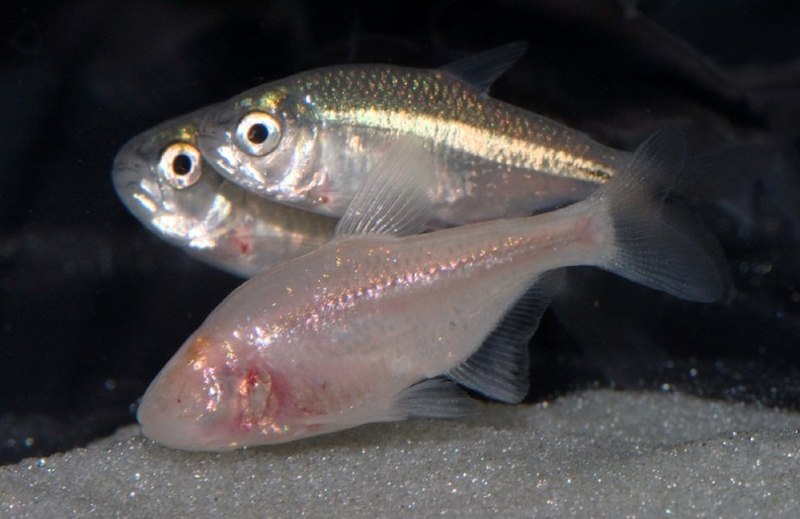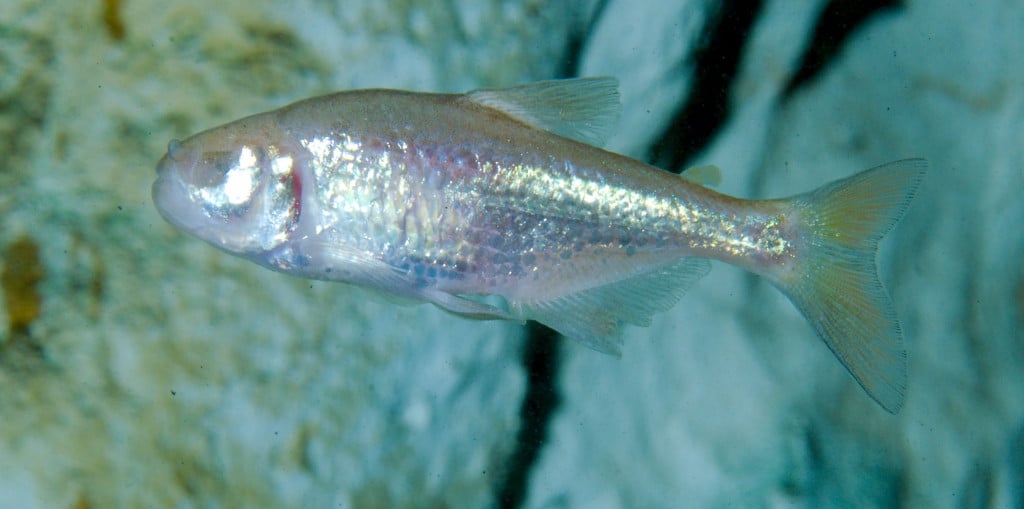Fish With No Eyes Caves Fish With No Eyes Caves Clip Art
The Mexican tetra evolved the power to live without sight when its surface-dwelling cousins shifted to living in dark limestone caves during the Pleistocene period.
Before nosotros get into the science stuff behind this peculiar bullheaded fish, allow me to tickle your funny bone. Hither's a joke for you.

A dumb joke! I agree
Now, it'south not uncommon to come up beyond a blind fish among a school of fish. There are some unfortunate individuals that are simply built-in without optics.
Still, are at that place any species where having no eyeballs is a part of their natural process of evolution?
Allow me introduce yous to Astyanax mexicanus, unremarkably known as the Mexican Blind Cavefish or the Blind Cave Tetra. They alive in a perpetual state of darkness for the vast majority of their lifespan. Their eye degeneration is considering the species did not pay any heed to the "use it or lose it" principle of evolution.
So why did the species undergo such drastic modification? And are they blind from nascence?
Recommended Video for you:
The Mexican Bullheaded Cavefish

The Mexican tetra (Photograph Credit : Grand-Duc/Wikimedia commons)
The mere idea of going into a cave without a flashlight and navigating the pitch darkness can be unnerving. Even so, the Mexican tetra has evolved the ability to live without sight. During the Pleistocene menses, the eyed, surface-dwelling (epigean) Astyanax fishes shifted to living in the limestone caves between key United mexican states and due south Texas. Over the years, their descendants evolved to lose their eyes and pigmentation, and have come to be known every bit the cave-dwelling house (hypogean) Mexican tetra.

Regions Astyanax mexicanus is plant (Photograph Credit : MiguelCampos /Wikimedia eatables)
Therefore, a unmarried species—Astyanax mexicanus—branched into two types: the surface-dwelling fish with both eyes and the cavern-dwelling fish with no eyes. The Mexican cavefish is a teleost fish that belongs to the society Characiformes. They are troglodytes, pregnant that they spend their lives in the darkness of caves in North United mexican states.
Like most troglodytes, the characteristics of Mexican cavefish include blindness, loss of pigmentation, enhanced tactile & chemical senses, advanced food-finding ability, reduced free energy needs, attraction to vibrations, shorter lifespan, reduced genetic diversity and smaller population sizes.
Are Mexican cavefish born without optics?
Mexican cavefish follow a like path of center germination equally their surface-living relatives A. mexicanus. The cavefish forms a pocket-size rudimentary middle for the offset 24 hours of embryonic development, simply soon after, the centre development arrests and starts the process of regressive changes, such equally eye degeneration and loss of pigmentation.

Two surface-home Astyanax mexicanus and a bullheaded cave-dwelling Mexican tetra (Photo Credit : Richard Borowsky /Wikimedia commons)
The first sign of degeneration is marked by the apoptosis (prison cell decease) of the lens, followed by retinal degeneration. Ultimately, the optics sink into orbit and the non-pigmented scales encompass the middle, merely like the residuum of the body.
What causes blindness?
The blindness in the Mexican tetra is caused by a few gene mutations, also referred to as the 'primary switches'. For Mexican cavefish, at that place is a primary switch that controls eye evolution. The switch tin disable the eye factor, rendering information technology useless. And this master switch in the cavefish is… shh.
No, information technology'south non a undercover… 'shh' refers to the sonic hedgehog molecule (Shh). "Sonic hedgehog" is a signaling molecule, not the cartoon character.

The incorrect kind of sonic hedgehog (Photograph Credit : Pixabay)
Shh is a powerful morphogen that controls the fate of cells in a developing brain. Information technology is responsible not only for modifications in eye development, but as well for the forebrain of the cavefish.
During early embryogenesis, the shh signals from the anterior midline of the neural plate decide the level of certain genes (Pax6, Pax2 and Vax1). These genes play a disquisitional function in tissue and organ formation during embryogenesis. Increased shh signaling leads to degeneration of the optics, while a lack of shh signals leads to the formation of slightly larger optics.
In the example of cavefish, an increment in levels of shh signaling is observed. This causes an imbalance between the Pax6, Pax2 and Vax1 levels. (Source). These genes are responsible for determining the gap between the two eyes and the size of the optic cups. This imbalance results in the germination of smaller optic cups and longer optic stalks. The over-expression of shh signals causes apoptosis of the lens and stops eye development.

The blind cavefish (Photo Credit : Flickr)
Still, the extent of cellular and molecular mechanisms involved in this mutation is not withal completely understood.
Why does this mutation occur?
All organisms have undergone and are still undergoing the evolutionary process. Some lose an ancestral characteristic to suit to their changing environment. The loss of the man tailbone is ane such classic case. Similarly, the cavefish lost its eyes and pigmentation due to the evolution of the species. Though the ane true explanation behind this mutation is not yet adamant, there are currently 3 theories for regressive changes in the cavefish.
- Direct natural selection: This theory provides a unproblematic explanation for the loss of the eye in the Mexican tetra. Since the habitat of the fish is a dark cave, the heart provides no visual advantage to the species. Instead, the absence of eyes helps them conserve their energy, as the food source is scarce in the caves. Maintaining the heart tissues and the optic fretfulness requires high amounts of metabolic energy.
- Indirect Selection: This employs the phenomenon of pleiotropy, where a single gene mutation affects more than one trait. The Shh signaling in cavefish negatively affects the eye, simply also has positive furnishings on the development of taste buds. An increase in the number of taste buds allows the fish to detect food more effectively. Thus, the species had to trade vision for more taste buds!
- Genetic Drift: This hypothesis suggests that natural selection had no part in the mutation seen in the Mexican tetra. Rather, the genetic mutation happened due to random events.
However, none of these theories have been definitively proven withal.
Conclusion
In a bargain with development, it appears that the cavefish bartered their optics for other senses that give them a amend chance of survival in the dark caves of Mexico. They gained actress gustation buds that aid them notice nutrient more quickly in the darkness of caves. Additionally, they have evolved a better mechano-sensory organisation, allowing them to perceive their environment by sensing vibrations.
All in all, existence bullheaded proved to be a major advantage to the cavern-dwelling species of Astyanax Mexicanus!
Suggested Reading
-
Darwin's Dubiousness: The Explosive Origin of Animal Life and the Instance for Intelligent Blueprint -
Undeniable: How Biology Confirms Our Intuition That Life Is Designed -
The Origin of Species: 150th Anniversary Edition
Was this article helpful?
Yes No
Assist united states make this article better
Source: https://www.scienceabc.com/nature/animals/why-are-all-mexican-cavefish-blind.html



0 Response to "Fish With No Eyes Caves Fish With No Eyes Caves Clip Art"
Post a Comment